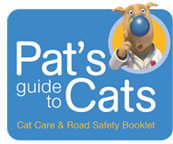Thanks to our partner, Petplan we are able to offer all users of FelineOnline.com access to this fantastic cat care eBook.
It is available for download – absolutely free of charge!
Enjoy a sample of the expert cat advice you can read about in the free eBook:
Introducing a new cat to the household
We think of cats and dogs as difficult to mix, and it is usually far easier to introduce a dog to a resident cat than it is to bring a new cat into the household, especially if it is an adult. Generally it is easier to introduce a young kitten as it seems to be much less of a threat to an adult cat and you can also manage it much more easily.
The most difficult scenario is bringing a new adult cat into the home of a totally indoor cat whose whole territory is bounded by the four walls of the house. With cats there is no guarantee that they will ever get on, however you can give them the best chance by recognising a few things which are very important to our feline friends.
Smell is more important to cats than sight. If the smell fits, they will relax and this is a tool you can use when introducing a new cat. Keep them apart initially (a few days to a week) in different rooms but pat one and then the other to mix their scents and even use a cloth to wipe around the cat’s face to collect some of the scents to dab around the house.
What you are trying to do is integrate the new smells with the old so that there is a new ‘group’ smell which the resident cat is happy with, and the new cat can fit in to.
If you have access to a kittening pen or dog pen (otherwise a cat carrier will do), then use this as a ‘safe house’ for the new cat (which will feel protected inside) while the resident can come and look, have a hiss and a spit and get to know the smell. Supervise some short introductions and gradually increase access. Then, when you feel the time is right, you can let them out together but give them high places to get away from each other.
Use food to get them to share space. In the winter the allure of a warm fire can overcome the most suspicious of cats and get them sitting in the same room together. It can take a long time to integrate a new cat and while many may never be on grooming terms, you have succeeded if they merely manage to live tolerantly alongside one another!Â
Poisons in the home
While dogs are prone to eating just about anything (especially if they are labradors), cats are usually much more sensible about not ingesting anything toxic just for the sake of eating it. However, they can be poisoned indirectly through ingesting rodents which have eaten poisoned bait. They also take in poisons via grooming. If they have a toxic substance on the coat, they will groom it off and ingest it that way. Cats can also absorb substances through their feet if they tread in them, eg creosote.
Poisoning in cats can be compounded further because cats have a peculiar physiology and lack certain liver enzymes, which means they cannot break down some chemicals and may be even more susceptible to some poisons. Dangerous substances include antifreeze and fuels, bleach, disinfectants and wood preservatives. Occasionally cats are given human medicines by accident – aspirin, paracetamol and antidepressants are very dangerous.
Garden hazards to avoid include rodent poisons such as warfarin, and strychnine; herbicides such as paraquat and sodium chlorate; some fungicides; insecticides such as pyrethrins, pyrethroids and organophosphates, organochlorides and slug bait, metaldehyde. All chemicals should be stored carefully and any spillages mopped up immediately.
There are also plants which can be poisonous to cats, although they do not usually eat these unless they are bored or are indoor cats looking for a substitute for the grass they nibble outside. The Feline Advisory Bureau has a leaflet listing poisonous plants both indoor and out.
For more helpful advice on cats, you can download or request a copy by post of the Pat’s guide to Cats by clicking here
Official Partner:

